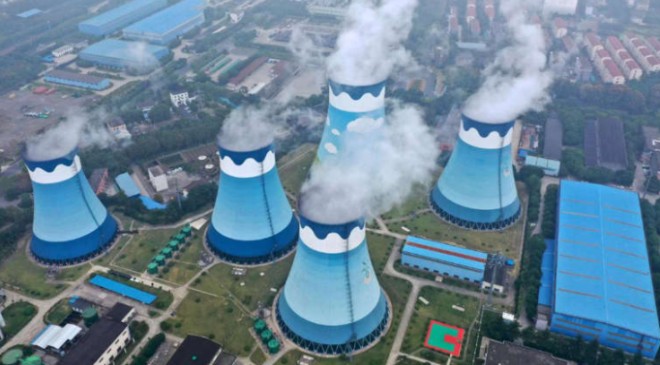Chinese officials are ordering coal plants to dramatically ramp up production. The European Union is facing a revolt over its ambitious Green Deal on climate. US President Joe Biden is petitioning OPEC nations to boost oil production.
So much for the fight against the climate crisis — it’s the energy crisis that’s taking precedence. And it couldn’t have come at a more crucial time.
In just three weeks, leaders and negotiators will meet for the COP26 international climate talks in the Scottish city of Glasgow. Momentum was building for putting an end date on coal and speeding up the global transition from climate-altering fossil fuels to renewables before the crisis hit.
But a rush back to fossil fuels is worrying some experts that this moment in time could slow down that transition, particularly on the phaseout of coal, now in closer reach than at any other time in history.
“The worry with China’s power crunch is that it appears to be strengthening the argument of pro-coal interests there that the transition to renewables is happening too fast,” said Christine Shearer, Global Energy Monitor’s program director for coal, which tracks the use of fossil fuels around the world.
With winter fast approaching and the global economy rebounding from the Covid-19 pandemic faster than the world had prepared for, governments are being forced to reach for sources of energy that are readily available. The infrastructure that exists to harness energy from renewables like wind and solar simply isn’t enough to meet demand.
“A lot of decision-makers are sort of panicking in some ways about the social response,” said Lisa Fischer, program leader at the European climate think tank E3G.
Throwing more money at fossil fuels is not a solution, she said, and some short-term solutions are contradictory to longer-term sustainable goals.
A better response would be to “turbocharge” funding for deploying renewable and energy efficiency programs, including getting infrastructure projects that were hampered by the pandemic, off the ground.
And there entails the dichotomy of the crisis — the world can either “turbocharge” efforts in renewables, or slow it down, and lean more on fossil fuels, as is happening now.
A geopolitical mess
There are several reasons for the energy crunch, beyond the rebound from the pandemic. Power from renewables has been below expectations — in the UK and continental Europe, the summer was less windy than usual, so wind power under-delivered. In China, lower rainfall meant less energy from the country’s hydropower plants.
On top of that, Russia has been accused of slowing gas supplies to Europe to encourage a faster approval process for its Nord Stream 2 gas pipeline that runs under the Baltic Sea to Germany. Gazprom denied the accusation to CNN last month, but on Thursday, Russia’s Deputy Prime Minister Alexander Novak said explicitly that gas prices would cool if Berlin certified the project.
Chinese authorities have kept mountains of coal imported from Australia sitting at docks for months, refusing to show Australia it is willing to take its exports as the two countries remain cold over Canberra’s calls for an investigation into the origins of Covid-19. That has only added to the power shortage in the country.
Chinese officials told companies in the country’s industrial heartlands last month to limit energy consumption to reduce demand for power, state media reported. Some provinces experienced blackouts in homes as supplies were cut. But as the crisis grows and global demand for Chinese goods soars, Beijing switched tack, telling coal miners to add a whopping 100 million metric tons to production, state media reported Thursday.
China was already powering its economic return with dozens of new coal plants, but the more recent increase in production is a problem for COP26 — China was just starting to show signs it was ready to play a part in putting an end date on the fossil fuel.
Chinese President Xi Jinping announced just two weeks ago that his country would stop financing coal projects abroad, removing the world’s biggest financial backer of fossil fuel internationally. It has since come under pressure, however, to do more to wind down coal at home.
China has said it plans to peak its emissions sometime before 2030, and hit carbon neutrality by 2060. But its flurry of coal plant building and increased production makes that even harder a goal to imagine.
A European split
China is not alone. In the face of this crisis, European leaders are signaling that fossil fuels are hard to quit.
Last month, the UK fired up an old coal plant to meet electricity demands. And some countries in the European Union are considering keeping coal and oil-burning plants open past their closure dates to avoid similar power cuts.
It’s a blow to the substantial gains Europe reported last year, when renewables generated more electricity than fossil fuels for the first time. In 2020, 38% of electricity was delivered by renewable energy, compared to 37% by fossil fuels.
It has also caused a rift in the EU parliament, where the climate crossroads is clear as day. In the face of an urgent crisis, some leaders say without an effective short-term action plan to counter consumers’ ballooning energy bills, the EU’s Green Deal will lose support.
Hungarian Prime Minister Viktor Orbán is leading that camp, blaming “bureaucrats in Brussels” for continually raising the price on energy from fossil fuels.
Kadri Simson, European commissioner for energy, on the other hand, said the Green Deal would provide the “only lasting solution to Europe’s energy challenge” and that more renewables and improved energy efficiency were the answer.
“We have to declare the current price hike has little to do with our climate policies, and much to do with our dependence on imported fossil fuels and the relative prices,” Simson said Wednesday.
“Wind and solar have continued to generate the cheapest electricity in Europe in recent months. They are not exposed to price volatility.”
A knock-on effect in the US
In the US, a crisis is brewing around soaring gasoline prices, a problem that is tied to the wider energy problem. Some countries that are struggling to get enough natural gas are turning to oil to fill the gap in the power supply.
In August, Biden petitioned the OPEC+ — a bloc of major oil-producing nations and their allies — to ramp up global oil production after gasoline prices soared, as an increase in supply would soften prices at the pump.
It hasn’t worked — OPEC+ said Monday it would only gradually add supply to the market. Either way, Biden’s calls for more oil sit at odds with his climate agenda, which includes boosting the country’s electric vehicles market.
According to the International Energy Agency, in order to reach net-zero by 2050 — where the amount of greenhouse gases emitted is not greater than the removed from the atmosphere — the world has to stop expanding fossil fuel production.
But some experts are hopeful that leaders will choose the harder but more rewarding path at COP26. While the UK has returned to coal in the short term, its department of Business for Business, Energy & Industrial Strategy on Thursday announced plans to fully decarbonize its electricity sector 15 years earlier than it previously planned.
“Going into the climate conference, the backdrop is demonstrating the extreme impacts of relying on fossil fuels — to my mind, I think that could be enough to push some countries on the fence to really double down on renewables,” said Charles Moore, director of the European Program at the think tank Ember Climate.
“I think UK is a great example. The UK just came out and committed to fully decarbonize the electricity system by 2035,” he said.
“That’s from the host of the climate conference.”

































